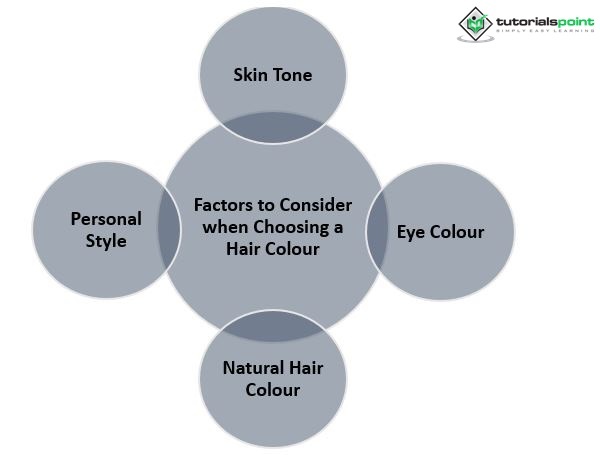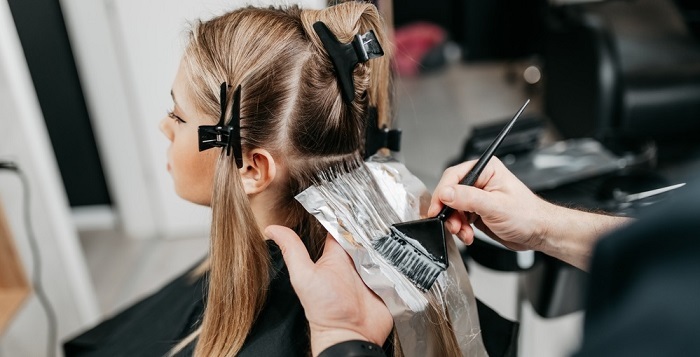

Choosing the right hair colour can enhance your natural beauty and transform your look. With so many options available, it's important to consider your skin tone, eye color, and personal style when selecting a hair color. In this guide, we'll explore different factors to consider when choosing and enhancing your hair color.

When choosing a hair color, there are several factors to consider to ensure that you select a shade that enhances your natural beauty and complements your skin tone and eye color. Here are some key factors to consider when choosing a hair color −
Skin Tone − Your skin tone is one of the most important factors to consider when choosing hair color. Cool skin tones typically look best with cool hair colours like ash blonde, while warm skin tones tend to look better with warm hair colours like golden brown.
Eye Colour − Your eye colour can also play a role in determining which hair colour will look best on you. For example, blue eyes tend to look great with cool hair colours like platinum blonde or ash brown, while green or hazel eyes can look stunning with warm hair colours like auburn or caramel.
Natural Hair Color − Your natural hair colour can also help guide your hair colour choices. If you have naturally dark hair, it may be more difficult to achieve a light blonde shade without damaging your hair. If you have naturally light hair, you may be able to achieve a wider range of colors.
Personal Style − Your personal style and preferences should also be taken into account when choosing a hair color. Do you want a bold and dramatic look, or something more subtle and natural? Consider what colours and styles you typically gravitate toward in fashion and makeup.

By considering these factors, you can select a hair colour that flatters your natural features and makes you feel confident and beautiful.
Matching your hair color to your skin tone and eye color can help enhance your natural beauty and ensure that you select a shade that complements your features. Here are some tips for matching hair colour to skin tone and eye color −
Cool Skin Tones − If you have a cool skin tone with blue or pink undertones,you'll typically look best with cool hair colours like ash blonde, platinum blonde, cool brown, or black
Warm Skin Tones − If you have a warm skin tone with yellow or golden undertones, you'll typically look best with warm hair colours like golden blonde, caramel brown, or auburn.
Neutral Skin Tones − If you have a neutral skin tone with a mix of warm and cool undertones, you can typically wear both warm and cool hair colors.
Blue Eyes − If you have blue eyes, cool hair colours like platinum blonde, ash brown, or cool black can help enhance your eye color.
Green or Hazel Eyes − If you have green or hazel eyes, warm hair colours like auburn, caramel, or golden brown can help bring out the green or gold tones in your eyes.
Brown Eyes − If you have brown eyes, a wide range of hair colours can look great, from warm caramel and chestnut to cool ash blonde and black.
By matching your hair color to your skin tone and eye color, you can create a cohesive and flattering look that enhances your natural beauty.
When it comes to choosing hair color, there are two main types: permanent and semi-permanent. Here's what you need to know about each type −
Permanent Hair Color − Permanent hair colour penetrates the hair shaft and lasts until the hair grows out or is cut. This type of hair colour is best for those who want a long-lasting change in hair color, and it typically provides complete grey coverage. However, it can be damaging to the hair if not done properly.
Semi-permanent Hair Color − Semi-permanent hair colour does not penetrate the hair shaft as deeply as permanent hair colour and typically lasts for 6–8 weeks. This type of hair colour is best for those who want a temporary change in hair colour or want to experiment with different shades. Semi-permanent hair colour is typically gentler on the hair than permanent hair color.
When choosing between permanent and semi-permanent hair colours, consider the amount of change you want to make to your hair colour and how long you want the colour to last. If you're not sure which type of hair colour is right for you, consult with a professional stylist who can help you make the best choice for your hair type and goals. Additionally, always follow the manufacturer's instructions and do a patch test before applying any hair colour to avoid allergic reactions.

Highlights and lowlights are two popular hair colouring techniques used to enhance the colour of the hair and add dimension. Here's what you need to know about each technique −
Highlights − Highlights are lighter strands of hair that are woven or painted onto the hair, typically using a lightening agent. This technique is used to add brightness and dimension to the hair, and it can be done on any hair color. Some popular highlight techniques include balayage, ombre, and foiling
Lowlights − Lowlights are darker strands of hair that are woven or painted onto the hair, typically using a colour that is darker than the natural hair color. This technique is used to add depth and richness to the hair, and it is especially useful for adding dimension to light hair colors. Lowlights can be done using a variety of techniques, including weaving and painting.
When done correctly, highlights and lowlights can add depth and dimension to the hair and help enhance the natural color. However, it's important to work with a professional stylist who has experience with these techniques to ensure that the colour is applied evenly and that the hair is not damaged during the colouring process. Additionally, be sure to use hair care products designed for color-treated hair to help maintain the vibrancy and health of the hair.
Maintaining hair colour and preventing damage are essential for keeping your hair looking healthy and vibrant. Here are some tips for maintaining hair colour and preventing damage −
Use a color-safe shampoo and conditioner − Choose a shampoo and conditioner that are specifically designed for color-treated hair. These products help to maintain the vibrancy of the hair colour and prevent fading.
Limit heat styling − Heat styling tools like flat irons, curling irons, and blow dryers can damage the hair and cause the colour to fade. Limit your use of heat styling tools or use them on a low heat setting to help prevent damage.
Protect your hair from the sun − The sun's UV rays can damage the hair and cause the colour to fade. Protect your hair from the sun by wearing a hat or using a leave-in conditioner with SPF.
Avoid harsh chemicals − Harsh chemicals such as chlorine and bleach can cause hair damage and faded color. If you swim in a pool, wear a swim cap or use a clarifying shampoo to remove chlorine from your hair. Avoid using bleach or other harsh chemicals on color-treated hair.
Regular trims help to remove split ends and prevent breakage, which can cause the colour of the hair to appear dull and faded.
By following these tips, you can help maintain your hair color and prevent damage, keeping your hair looking healthy and vibrant for longer. Additionally, be sure to consult with a professional stylist if you have any questions or concerns about maintaining your hair color.
Hair colour mistakes can happen, and it can be frustrating when you don't get the results you were hoping for. Here are some tips for correcting hair colour mistakes −
Don't Panic − If your hair colour didn't turn out the way you wanted, take a deep breath and don't panic. Most mistakes in hair colour can be fixed with time and patience.
Assess the Situation − Take a good look at your hair colour and try to identify what went wrong. Did the colour turn out too dark, too light, or too brassy? Understanding what went wrong can help you determine how to fix it.
Consider a Colour Correction − If the mistake is significant, you may need a colour correction. This is best done by a professional stylist who has experience with colour corrections.
Use a Colour Remover − If the mistake is minor, you may be able to fix it with a colour remover. There are several colour removers available that can help remove unwanted hair colour without damaging the hair.
Add Highlights or Lowlights − If your hair colour is too light or too dark, adding highlights or lowlights can help to correct the colour and add dimension to the hair.
Wait it Out − If the mistake is minor and you're not ready to make a big change, you may be able to wait it out. Over time, the colour will fade and your natural hair colour will start to show through.
Remember that correcting hair colour mistakes can take time and patience, and it's important to be gentle with your hair during the process. Additionally, be sure to consult with a professional stylist if you have any questions or concerns about correcting hair colour mistakes.
Choosing and enhancing your hair colour can be a fun way to switch up your look and express your personal style. However, it's important to consider factors like skin tone, eye color, and hair texture when choosing a colour and to take steps to maintain the colour and prevent damage. If you do experience a colour mistake, don't panic—there are ways to correct it, whether it's with a colour remover, colour correction, or adding highlights or lowlights. With the right care and attention, you can enjoy beautiful, vibrant hair colour that makes you feel confident and stylish.